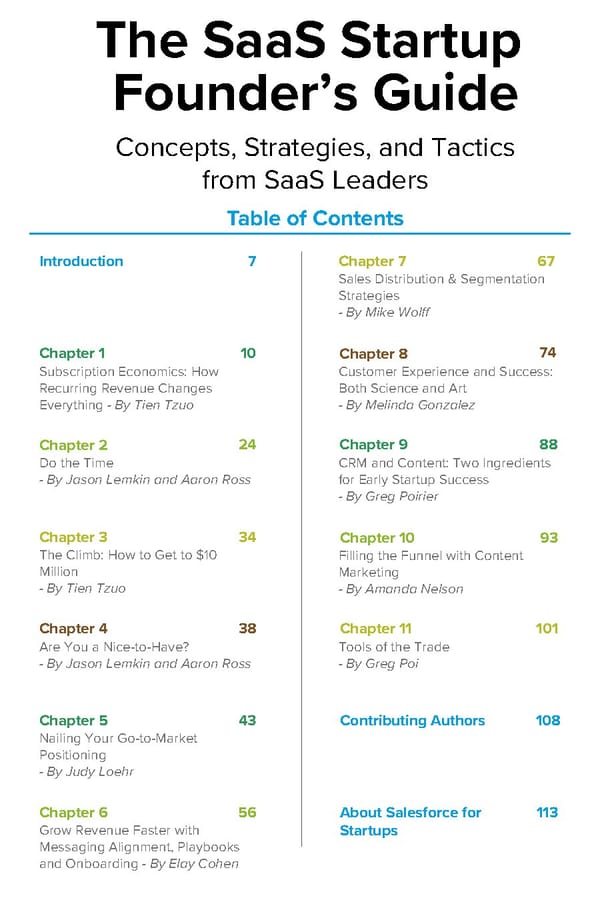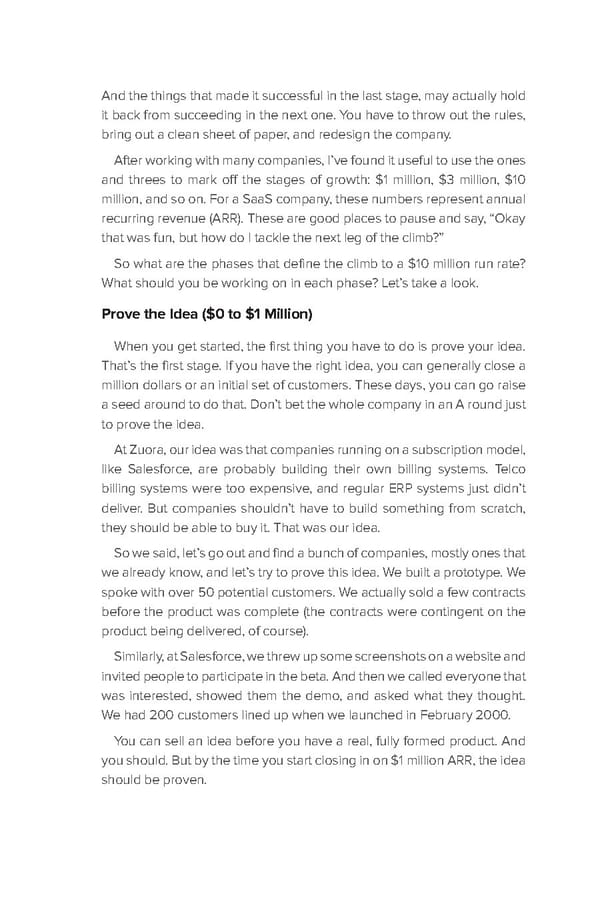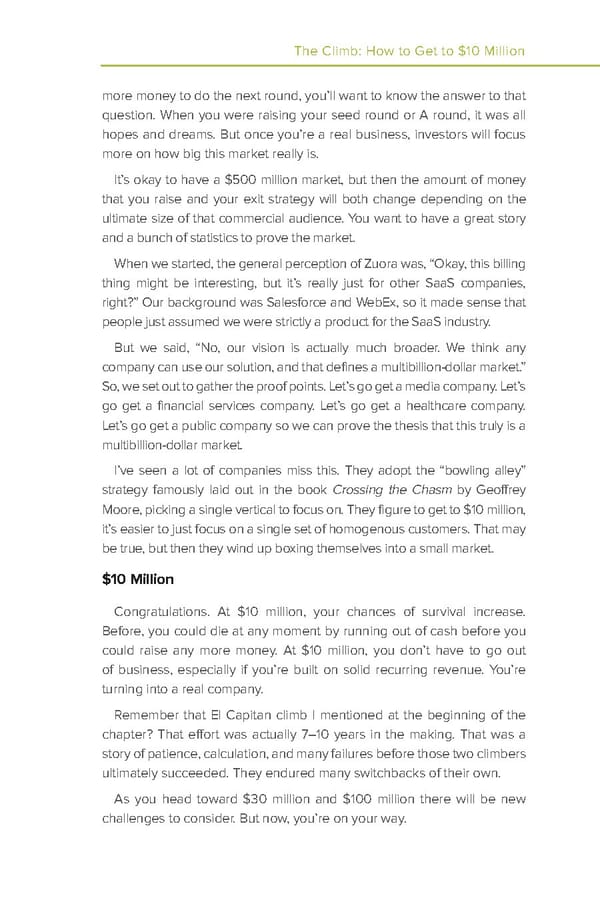The Climb
By Tien Tzuo, Founder and CEO, @Zuora. Best Selling Author of "Subscribed"
The SaaS Startup Founder’s Guide Concepts, Strategies, and Tactics from SaaS Leaders Table of Contents Introduction 7 Chapter 7 67 Sales Distribution & Segmentation Strategies - By Mike Wolff Chapter 1 10 Chapter 8 74 Subscription Economics: How Customer Experience and Success: Recurring Revenue Changes Both Science and Art Everything - By Tien Tzuo - By Melinda Gonzalez Chapter 2 24 Chapter 9 88 Do the Time CRM and Content: Two Ingredients - By Jason Lemkin and Aaron Ross for Early Startup Success - By Greg Poirier Chapter 3 34 Chapter 10 93 The Climb: How to Get to $10 Filling the Funnel with Content Million Marketing - By Tien Tzuo - By Amanda Nelson Chapter 4 38 Chapter 11 101 Are You a Nice-to-Have? Tools of the Trade - By Jason Lemkin and Aaron Ross - By Greg Poi Chapter 5 43 Contributing Authors 108 Nailing Your Go-to-Market Positioning - By Judy Loehr Chapter 6 56 About Salesforce for 113 Grow Revenue Faster with Startups Messaging Alignment, Playbooks and Onboarding - By Elay Cohen
Chapter 3 The Climb: How to Get to $10 Million By Tien Tzuo In the preceding chapter, Jason Lemkin provides us insights into what it takes to build a successful and sustainable SaaS business. There are no overnight successes, and even the most vital of solutions take years to prove out — with a viable business model and strong annual recurring profits. In this chapter, Tien metaphorically takes us on the climb from initial revenue to $10 million ARR. Tien neatly dissects the journey into three key phases — proving the idea, proving the product, and finally, proving the market. You could’ve gotten a nice, comfortable job at a nice, comfortable organization, but instead, you decided to take some risks and start your own company. You decided to dream big. So, how do you build the next Salesforce? How do you create the next billion-dollar success story? You have to start somewhere. Lots of people think that success is a linear path. When they look at success, they look at the end result, jumping to the outcome and skipping over the boring, hard stuff that must have happened along the way. But the path to success isn’t straight. Success is achieved through a series of twists and turns, through a series of challenges that must have been solved, not through one brilliant move. I like to say that building a business is a lot like climbing a mountain. Now, unlike those two crazy guys that free-climbed El Capitan, most of us don’t scramble straight up 3,000 feet of granite when we go up a mountain. Instead, we make our way along a route that has lots of switchbacks. I like the metaphor of a switchback, because at each turn you’re doing an about-face. You’re completely switching directions. Similarly, when a company enters a new phase, it practically becomes a new organization.
And the things that made it successful in the last stage, may actually hold it back from succeeding in the next one. You have to throw out the rules, bring out a clean sheet of paper, and redesign the company. After working with many companies, I’ve found it useful to use the ones and threes to mark off the stages of growth: $1 million, $3 million, $10 million, and so on. For a SaaS company, these numbers represent annual recurring revenue (ARR). These are good places to pause and say, “Okay that was fun, but how do I tackle the next leg of the climb?” So what are the phases that define the climb to a $10 million run rate? What should you be working on in each phase? Let’s take a look. Prove the Idea ($0 to $1 Million) When you get started, the first thing you have to do is prove your idea. That’s the first stage. If you have the right idea, you can generally close a million dollars or an initial set of customers. These days, you can go raise a seed around to do that. Don’t bet the whole company in an A round just to prove the idea. At Zuora, our idea was that companies running on a subscription model, like Salesforce, are probably building their own billing systems. Telco billing systems were too expensive, and regular ERP systems just didn’t deliver. But companies shouldn’t have to build something from scratch, they should be able to buy it. That was our idea. So we said, let’s go out and find a bunch of companies, mostly ones that we already know, and let’s try to prove this idea. We built a prototype. We spoke with over 50 potential customers. We actually sold a few contracts before the product was complete (the contracts were contingent on the product being delivered, of course). Similarly, at Salesforce, we threw up some screenshots on a website and invited people to participate in the beta. And then we called everyone that was interested, showed them the demo, and asked what they thought. We had 200 customers lined up when we launched in February 2000. You can sell an idea before you have a real, fully formed product. And you should. But by the time you start closing in on $1 million ARR, the idea should be proven.
Chapter 3 The Climb: How to Get to $10 Million Prove the Product ($1 Million to $3 Million) After your first million you can say to yourself, “Okay people like the idea. They’ll pay for it.” But what were they really paying for? In the previous phase, you were probably testing a whole range of ideas, seeing which of the ideas will actually stick. But now it’s time to change course. Now, it’s time to focus and do some editing. What is the product you really need to build? While proving the idea, you may have tested all sorts of different ideas, but now it’s time to cull, to prioritize, and to think through what you have to build first, and what can be pushed out to later years. The reverse can also be true. At Zuora, we thought a simple billing system was sufficient. Then, we realized our customers needed a lot more — we had to add APIs, payment systems, e-commerce platforms, tax engines, and so on. We realized during this phase that we needed a very broad product. Now, proving the product doesn’t mean you have to have the entire thing finished, but you should have enough of an understanding to be able to win in the marketplace, and lay out a coherent product roadmap that will drive your engineering efforts for quarters or years to come. That’s really the learning phase, and you want to have all that discovery done by the time you approach the $3 million market and begin the next phase. Because by that point, you won’t have time to dramatically re- engineer your product — you’ll be looking to scale. Prove the Market ($3 Million to $10 Million) The scale up from $3 million to $10 million is very exciting. If you’ve done a good job proving the idea, and now have a solid roadmap that resonates with customers, then you’re likely trying to do the $3 million to $10 million run as fast as possible. At this stage, you’re hiring a bunch of salespeople, spending significant budget on marketing, and your engineers are focused on executing the roadmap. Some companies do the $3 million to $10 million run in a year (or less). But as you go through this process, you also need to define your market. Ask yourself: Is your chosen market truly a multibillion-dollar market? Is it a $500 million market? Is it a $100 million market? When you start raising
Chapter 3 The Climb: How to Get to $10 Million more money to do the next round, you’ll want to know the answer to that question. When you were raising your seed round or A round, it was all hopes and dreams. But once you’re a real business, investors will focus more on how big this market really is. It’s okay to have a $500 million market, but then the amount of money that you raise and your exit strategy will both change depending on the ultimate size of that commercial audience. You want to have a great story and a bunch of statistics to prove the market. When we started, the general perception of Zuora was, “Okay, this billing thing might be interesting, but it’s really just for other SaaS companies, right?” Our background was Salesforce and WebEx, so it made sense that people just assumed we were strictly a product for the SaaS industry. But we said, “No, our vision is actually much broader. We think any company can use our solution, and that defines a multibillion-dollar market.” So, we set out to gather the proof points. Let’s go get a media company. Let’s go get a financial services company. Let’s go get a healthcare company. Let’s go get a public company so we can prove the thesis that this truly is a multibillion-dollar market. I’ve seen a lot of companies miss this. They adopt the “bowling alley” strategy famously laid out in the book Crossing the Chasm by Geoffrey Moore, picking a single vertical to focus on. They figure to get to $10 million, it’s easier to just focus on a single set of homogenous customers. That may be true, but then they wind up boxing themselves into a small market. $10 Million Congratulations. At $10 million, your chances of survival increase. Before, you could die at any moment by running out of cash before you could raise any more money. At $10 million, you don’t have to go out of business, especially if you’re built on solid recurring revenue. You’re turning into a real company. Remember that El Capitan climb I mentioned at the beginning of the chapter? That effort was actually 7–10 years in the making. That was a story of patience, calculation, and many failures before those two climbers ultimately succeeded. They endured many switchbacks of their own. As you head toward $30 million and $100 million there will be new challenges to consider. But now, you’re on your way.




